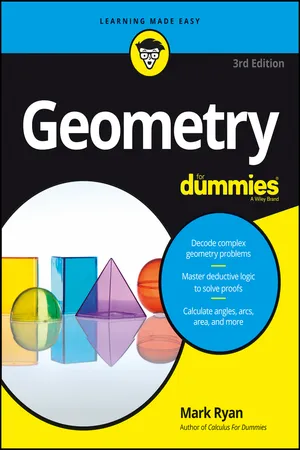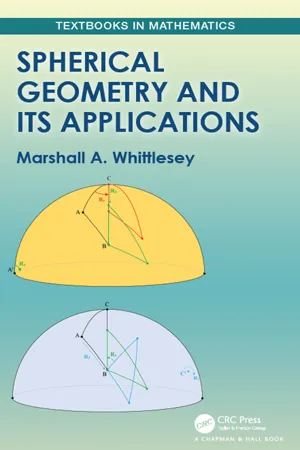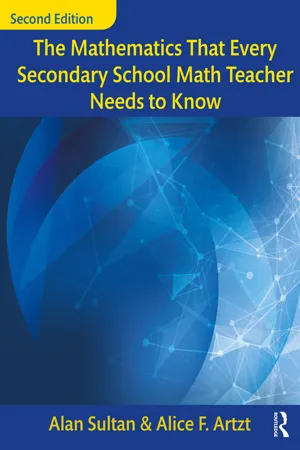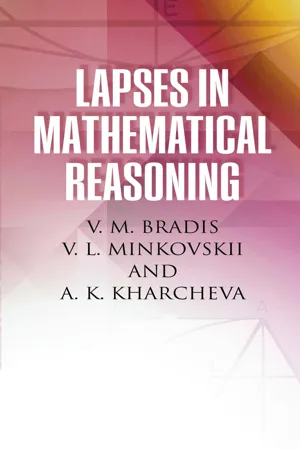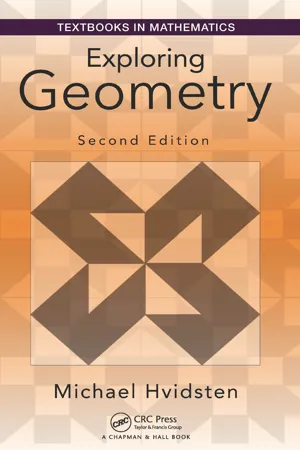Mathematics
SAS Theorem
The SAS (Side-Angle-Side) Theorem states that if two sides and the included angle of one triangle are congruent to two sides and the included angle of another triangle, then the triangles are congruent. This theorem is a fundamental concept in geometry and is used to prove the congruence of triangles in various geometric problems.
Written by Perlego with AI-assistance
Related key terms
7 Key excerpts on "SAS Theorem"
- eBook - ePub
- Walter A. Meyer(Author)
- 2006(Publication Date)
- Academic Press(Publisher)
C ′ — that is, the triangles are congruent.Figure 2.2 Side-angle-side axiom (the given parts are in solid lines).The argument just given seems a lot like a proof of the SAS axiom, but we have not labeled the SAS principle a theorem, which we would do if we had a proof of it. The reason our argument is not a proof is that it relies on the assumption that figures can be moved without changing the sizes of their sides and angles. There is no reason that such an axiom could not be added to our set of axioms — it is, after all, quite believable. However, it is common to exclude ideas of motion from the axioms of Euclidean geometry (but not from our intuitions about geometry), and we follow this approach.Here is our first deduction from the SAS axiom: the well-known theorem that base angles of isosceles triangles are congruent. Recall that a triangle is an isosceles triangle if it has two congruent sides (Figure 2.3 ).Figure 2.3 Base angles of an isosceles triangle are congruent.* THEOREM 2.1
If two sides of a triangle are congruent, say, AB = BC in Figure 2.3 , then the angles opposite these sides are congruent, m ∠A = m ∠C .PROOF
The idea is to show that A → C , B →B , C →A is a congruence of the triangle to itself. Under this 1:1 correspondence, ∠B corresponds to itself and is clearly congruent to itself, so we have the “angle” part of an SAS proof. For , the corresponding side is , and these are congruent by hypothesis. For , the corresponding side is , and these are congruent by the same hypothesis. By SAS, the correspondence is a congruence. Consequently m ∠A = m ∠C since these are corresponding angles.Our proof of Theorem 2.1 - eBook - ePub
- Walter Meyer(Author)
- 2022(Publication Date)
- Chapman and Hall/CRC(Publisher)
Section 3 of the previous chapter) says the work can be cut down. Here is the SAS axiom again.The SAS Axiom
IfAxiom 8: The SAS Congruence Axiom- one angle of a triangle, say A, is congruent to a certain angle of a second triangle, say A’; and if
- one side forming the angle in the first triangle, say , is congruent to a side forming the congruent angle, sayA B¯, in the second triangle; and ifA ' B '¯
- the remaining side forming the angle in the first triangle, , is congruent to the remaining side forming the congruent angle in the second triangle,A C¯, then the triangles are congruent with the correspondence A → A’, B → B’, C → C’. Briefly, we may write ABC ≅ A’B’C' with the order by which we list the vertices indicating what corresponds to what.'A ' C¯
Example 2.2: Why We Should Believe the SAS AxiomIn Figure 2.2 , suppose m∠A = m∠A', AB = A'B', and AC = A'C' (note that we have used solid lines in the figure to indicate the known parts). It seems obvious that the given information implies that BC = B'C', m∠B = m∠B', and m∠C = m∠C'. As an informal argument for this conclusion, imagine moving triangle ABC so that vertex A falls on vertex A',falls on top ofA B¯, andA ' B '¯falls on top ofA C¯. Clearly, B, in its new position, is the same point as B'. Likewise, C, in its new position, is the same point as C'. In other words, the two triangles coincide exactly. Now, the motion of the first triangle doesn't change its length or the measures of any angles. Consequently, the parts of the original ABC are congruent to the corresponding parts of A'B'C'A ' C '¯ - eBook - ePub
- Mark Ryan(Author)
- 2016(Publication Date)
- For Dummies(Publisher)
(If you fill in numbers, you can see that if and were both, and would both be.) Here’s the formal proof: © John Wiley & Sons, Inc. ASA: Taking the angle-side-angle tack ASA (Angle-Side-Angle): The ASA postulate says that if two angles and the included side of one triangle are congruent to two angles and the included side of another triangle, then the triangles are congruent. (The included side is the side between the vertices of the two angles.) See Figure 9-5. © John Wiley & Sons, Inc. FIGURE 9-5: The congruence of two pairs of angles and the side between them make these triangles congruent. Here’s a congruent-triangle proof with the ASA postulate: © John Wiley & Sons, Inc. Here’s my game plan: Note any congruent sides and angles in the diagram. First and foremost, notice the congruent vertical angles (I introduce vertical angles in Chapter 2). Vertical angles are important in many proofs, so you can’t afford to miss them. Next, midpoint E gives you. So now you have a pair of congruent angles and a pair of congruent sides. Determine which triangle postulate you need to use. To finish with SAS, you’d need to show ; and to finish with ASA, you’d need. A quick glance at the bisected angles in the givens (or the title of this section, but that’s cheating!) makes the second alternative much more likely. Sure enough, you can get because a given says that half of () is congruent to half of (). That’s a wrap. Here’s how the formal proof plays out: © John Wiley & Sons, Inc. STICKING TO THE BASICS: THE WORKINGS BEHIND SSS, SAS, AND ASA The idea behind the SSS postulate is pretty simple. Say you have three sticks of given lengths (how about 5, 7, and 9 inches?) and then you make a triangle out of them. Now you take three more sticks of the same lengths and make a second triangle - eBook - ePub
- Marshall Whittlesey(Author)
- 2019(Publication Date)
- Chapman and Hall/CRC(Publisher)
π, and this sum is not generally the same from one triangle to another.However, the angle sum theorem in the plane depends on the parallel postulate, and in fact the SAA congruence theorem in the plane does not depend on the parallel postulate. The reader will find a proof of SAA congruence in the plane in [Mo1963] (or [MD1982]) which makes use of the exterior angle theorem in the plane (which states that an exterior angle of a triangle has measure greater than the measures of either of the opposite interior angles). The spherical analogue of this theorem also turns out to be false.In plane geometry the SSA correspondence does not guarantee congruence of triangles, although we might say that it almost does. Knowledge of the measures of two sides and an angle that is not included leads to the so-called “ambiguous case” in determining the other sides of the triangle. The other sides are uniquely determined if the angle is a right angle, but otherwise there are either two possibilities for the other sides and angles, or the triangle cannot be constructed at all.We can make an immediate observation for spherical geometry: either SSA and SAA both guarantee congruence of triangles or neither does. The reason is that if one guarantees congruence, then we could prove that the other does as well by employing the same argument with polar triangles used in the proofs of ASA and AAA congruence. For example, suppose there were an SAA congruence theorem. To prove that an SSA correspondence guarantees congruence, we would consider two triangles which have an SSA correspondence. Their polar triangles would have an SAA correspondence by Theorem 11.19, and hence would be congruent. The congruence of the pair of polar triangles would in turn guarantee (by Theorem 11.19 again) that the original triangles be congruent. A similar line of reasoning would allow us to use an SSA congruence theorem to prove an SAA congruence theorem. - Alan Sultan, Alice F. Artzt(Authors)
- 2017(Publication Date)
- Routledge(Publisher)
The first result we talk about is something we are all familiar with: If three sides of one triangle have the same lengths as three sides of another triangle, then the triangles are congruent. That is, all their corresponding parts match! This is quite remarkable since we have said nothing about the angles of these triangles. Yet, this follows immediately from the Law of Cosines.Theorem 5.2 (SSS = SSS) If the three sides of triangle ABC are congruent to the three sides of triangle DEF, then the triangles ABC and DEF are congruent .Proof . Let us assume that the sides that match are a and d, b and e , and c and f . (Refer to Figure 5.2 .) So a = d, b = e , and c = f . From equation (5.8) we have thatcos C =a 2+b 2-c 22 a b(5.11) and using the same law in triangle DEF with the corresponding sides, we havecos F =.d 2+e 2-f 22 d e(5.12) Since a = d, b = e , and c = f we can substitute them in equation (5.11) to getcos C =d 2+e 2-f 22 d e(5.13) and we see from equations (5.12) and (5.13) thatcos C = cos F .(5.14) It follows that ∡C = ∡F .In a similar manner using the other versions of the Law of Cosines, equations (5.9) and (5.10) , we can show that ∡A = ∡D and ∡B = ∡E .Thus, if three sides of one triangle are equal to three sides of another triangle, then the corresponding angles match, and so the triangles are congruent.Note: In the proof of Theorem 5.2 (refer to equation (5.14) ), we used the fact that, if cos C = cos F , then ∡C = ∡F . While you may have accepted this, much more is involved in this statement than meets the eye. For now, we will use this fact continually and ask you to accept it. But, we will examine the reason behind it in a later section on technical issues. We now turn to a corollary of our SSS congruence theorem.Corollary 5.3 (HL = HL) Two right triangles are congruent if the hypotenuse and leg of one triangle are congruent to the hypotenuse and leg of the other triangle .Proof . In Figure 5.3 we see two right triangles where the hypotenuse and leg of one have the same lengths as the hypotenuse and leg of the other.We will show the third sides of the triangles have the same length. By the Pythagorean Theorem,Figure 5.3- eBook - ePub
- V. M. Bradis, L. Minkovskii, A. K. Kharcheva(Authors)
- 2016(Publication Date)
- Dover Publications(Publisher)
III. Stories, with Explanations, of Causes of Erroneous Reasoning63. Similar triangles with equal sidesTake two similar scalene triangles and denote the sides of the first in the order of increasing size by the letters a, b, c (a < b < c), and the corresponding sides of the second by the letters a1 , b1 , c1 . By virtue of proportionality of the corresponding sides of similar polygons we have: a1 = aq, b1 = bq, c1 = cq, where q is the coefficient of proportionality, and therefore a1 < b1 < c1 .If q = 1, then all the sides of the two triangles are respectively equal, and the triangles are congruent. The congruence of the triangles is thus a special case of similarity.It may seem, that if the triangles are similar, but not congruent, then they have no equal sides. The erroneousness of such a conclusion is shown by a simple consideration of triangles with the sides 8, 12, 18 cm, and 12, 18, 27 cm. The sides of the second are one-and-one-half times as large as the corresponding sides of the first, and therefore the triangles are similar (but not congruent). As we see, these two triangles have two pairs of respectively equal sides.We shall establish the conditions which have to be satisfied by two similar, but not congruent, triangles having two pairs of respectively equal sides.Suppose that q > 1. The smallest side a of the first triangle (with the sides a, b, c) is less than the smallest side a1 of the second triangle (with sides a1 = aq, b1 = bq, c1 = cq), and cannot be equal to any of the sides of the latter.The middle side b of the first triangle may be equal only to the smallest side a1 of the second triangle (since b is less than b1 = bq and much smaller than c1 = cq), and the greatest side c of the first triangle is equal either to the smallest side a1 or to the middle side b1 of the second triangle. If two sides of the first triangle are equal to two sides of the second triangle, then b = a1 , c = b1 . Hence b = aq, c = bq = aq × q = aq2 . Thus the sides of the first triangle form a geometric progression a, aq, aq2 . The sides of the second triangle are equal to aq, aq2 , aq3 - eBook - ePub
- Michael Hvidsten(Author)
- 2016(Publication Date)
- Chapman and Hall/CRC(Publisher)
Corollary 2.26 , we get that=D GD ED HD FSince, we get≅D G¯andA B¯≅D H¯A C¯A similar argument can be used to show that=A BD EA CD F□ Another important similarity condition is the SAS condition.=A BD EB CE FTheorem 2.29 .(SAS Similarity) If in two triangles there is a correspondence in which two sides of one triangle are proportional to two sides of the other triangle and the included angles are congruent, then the triangles are similar (Figure 2.23 ).Figure 2.23 SAS similarityProof: Let triangles ΔABC and ΔDEF be as specified in the theorem with=A BD EA CD FIfandA B¯are congruent to their counterparts in ΔDEF , then the triangles are congruent by SAS and thus are similar as well. We may then assume thatA C¯andA B¯are greater than their counterparts in ΔDEF . OnA C¯andA B¯there must be points G and H such that AG = DE and AH = DF . It is left as an exercise to show thatA C¯andG H↔are parallel and thus the angles at B and C are congruent to the angles at E and F . □B C↔Exercise 2.5.1 . In ΔABC let points D and E be the midpoints of sidesandA B¯. Show that DE must be half the length ofA C¯.B C¯Exercise 2.5.2 .Fill in the gap in Theorem 2.29 . That is, show in Figure 2.23 that.andG H↔are parallelB C↔Exercise 2.5.3 . (SSS Similarity Condition) Suppose that two triangles have three sides that are correspondingly proportional. Show that the two triangles must be similar .Exercise 2.5.4 . Let ΔABC be a right triangle with the right angle at C. Let a, b, and c be the side lengths of this triangle. Letbe the altitude to sideC D¯A B¯
Index pages curate the most relevant extracts from our library of academic textbooks. They’ve been created using an in-house natural language model (NLM), each adding context and meaning to key research topics.


